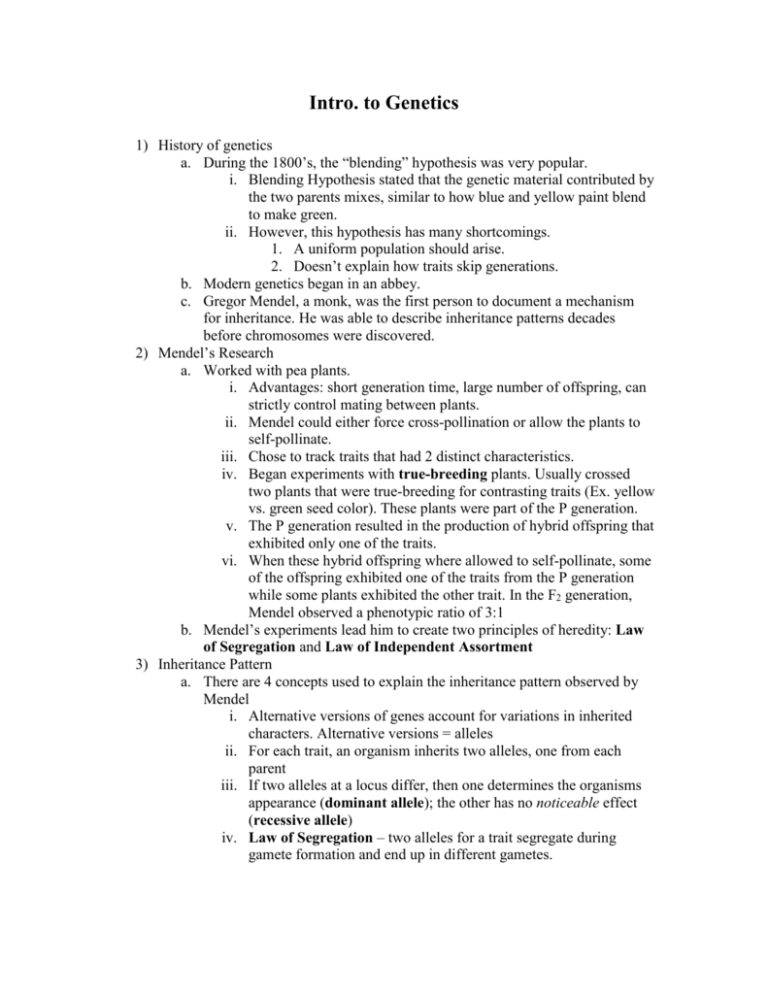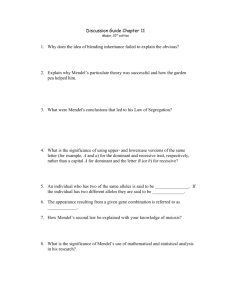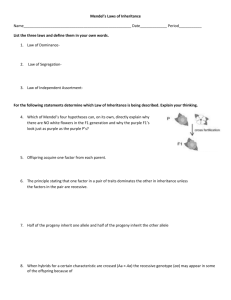Intro. to Genetics
advertisement

Intro. to Genetics 1) History of genetics a. During the 1800’s, the “blending” hypothesis was very popular. i. Blending Hypothesis stated that the genetic material contributed by the two parents mixes, similar to how blue and yellow paint blend to make green. ii. However, this hypothesis has many shortcomings. 1. A uniform population should arise. 2. Doesn’t explain how traits skip generations. b. Modern genetics began in an abbey. c. Gregor Mendel, a monk, was the first person to document a mechanism for inheritance. He was able to describe inheritance patterns decades before chromosomes were discovered. 2) Mendel’s Research a. Worked with pea plants. i. Advantages: short generation time, large number of offspring, can strictly control mating between plants. ii. Mendel could either force cross-pollination or allow the plants to self-pollinate. iii. Chose to track traits that had 2 distinct characteristics. iv. Began experiments with true-breeding plants. Usually crossed two plants that were true-breeding for contrasting traits (Ex. yellow vs. green seed color). These plants were part of the P generation. v. The P generation resulted in the production of hybrid offspring that exhibited only one of the traits. vi. When these hybrid offspring where allowed to self-pollinate, some of the offspring exhibited one of the traits from the P generation while some plants exhibited the other trait. In the F2 generation, Mendel observed a phenotypic ratio of 3:1 b. Mendel’s experiments lead him to create two principles of heredity: Law of Segregation and Law of Independent Assortment 3) Inheritance Pattern a. There are 4 concepts used to explain the inheritance pattern observed by Mendel i. Alternative versions of genes account for variations in inherited characters. Alternative versions = alleles ii. For each trait, an organism inherits two alleles, one from each parent iii. If two alleles at a locus differ, then one determines the organisms appearance (dominant allele); the other has no noticeable effect (recessive allele) iv. Law of Segregation – two alleles for a trait segregate during gamete formation and end up in different gametes. 4) Based on Mendel’s inheritance pattern, he was able to begin predicting the ratio of offspring. Today we use Punnett squares in order to predict the allele composition of offspring. a. The 3:1 is a standard ratio for a cross between two hybrid organisms for a trait the follows the dominant/recessive inheritance pattern. b. We can also use Punnett squares to attempt to figure out the genetic make up of an individual. By breeding an organism with an unknown genotype with an individual of a homozygous recessive genotype, we can reveal the genotype of the parent. This is called a testcross. 5) Law of Independent Assortment a. Mendel was able to devise this law by following 2 traits. b. Mendel bred two plants that were true-breeding but different in two traits. The cross between these two true-breeding individuals results in offspring that are dihybrid (heterozygous for 2 triats). c. If the traits followed, dependent assortment, then the dominant alleles would separate out together and the recessive alleles would separate out together. However, Mendel’s crosses showed plants that exhibit both dominant traits, one dominant and one recessive trait, and both recessive traits. d. Law of Independent Assorment – each pair of alleles segregates independently of each other pair of alleles during gamete formation 6) Probability and Genetics a. The laws of probability play an important factor in genetics. They can be used to help us determine the chances of a given genotype for an offspring, especially when we are looking at 3 or more traits. i. Ex. Male vs. Female = ii. Hyhbrid x Hybrid = iii. Dihybrid x Dihybrid = b. Standard genotypic and phenotypic ratios for Dominant/Recessive Cross Genotypic Phenotyic Purebred x Purebred Purebred x Hybrid Hybrid x Hybrid Dihybrid x Dihybrid






